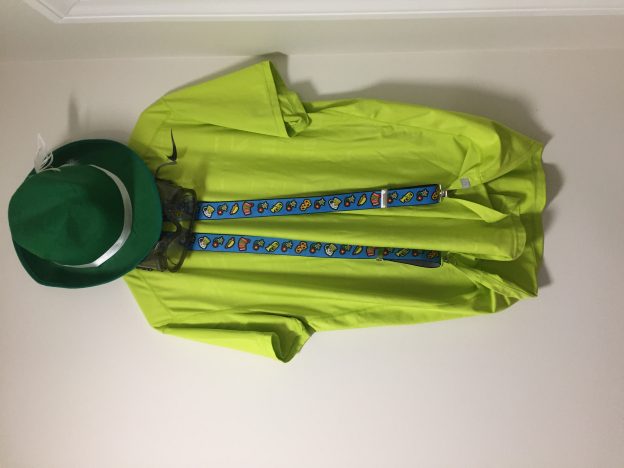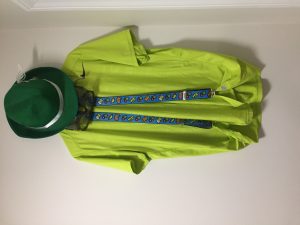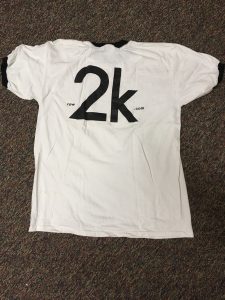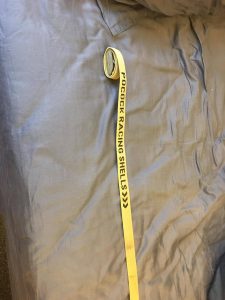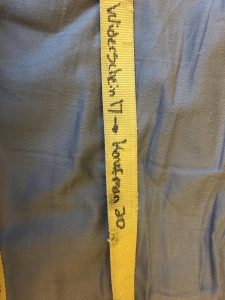Title: Flair/Dyed Hair
General Information about Item:
- Material: Clothing
- Language: English
- Country where Item is from: USA
Informant #1 Data:
Ethan Isaacson lives in Lexington, Massachusetts, and is currently a student at Dartmouth in the class of 2018. He was born on January 5th, 1996, and is studying chemistry and physics. He went on freshman trips when he was an incoming freshman, was a trip leader his sophomore year, and was on Hanover Croo, known as HCroo, this past fall, so has seen many different aspects of the trips program.
Leigh Steinberg was born and raised in Philadelphia, Pennsylvania, and was born on April 19, 1996. She is a student at Dartmouth in the class of 2018 and is a history major and plans on going into consulting after graduation. She was a trip leader before her sophomore year of college and was on Hanover Croo, known as HCroo, this past fall.
Informant #2 Data:
- The informant is a Dartmouth ’18 male. He went on a first-year trip in September 2014 and was a member of Lodj Croo in September 2017.
Informant #3 Data:
- The informant is a Dartmouth ’18 female. She went on a first-year trip in September 2014, was a member of Lodj Croo in September 2015, and served as one of the two Lodj Croo Captains in September 2017.
Informant #4 Data:
- The informant is a Dartmouth ’18 female. She is active in the Native American Community on campus, SPCSA, and Sigma Delta. She is a Government and Native American Studies modified with Anthropology double major from Martha’s Vineyard. She went on cabin camping in September 2014, but never led a trip or was on a croo.
Contextual Data:
People are wearing flair and have dyed hair from the first moment freshman arrive on campus. Flair is also prevalent during many other times at Dartmouth, like weekend social events and club meetings. It is used as a sign of expression and individuality at Dartmouth.
Item:
All Croos are known for wearing a lot of flair during trips and also are known for dying their hair wild colors. They do so in order to try to teach the incoming freshman to have a good time and not worry about what other people think about them, as the Croos all look ridiculous but they do not care. It also serves a practical purpose, as it helps distinguish who the Croolings are versus who are trip leaders and trippees. This tradition has been going as long as they know.
Transcript of Informant #1 Interview:
So part of it is that we look crazier and more embarrassing than they ever could. There’s a line in the safety show that goes, “nobody cares about your clothing. Look at us we look like clowns.” And I think that’s partially true that it’s a cool approach that they can’t look more ridiculous. Um but also the craziness is an interesting part of trips culture and Dartmouth culture and it’s just the sense of them being inducted into this very insular and weird community that accepts them fairly unconditionally. And that the crazy colorful appearances are a physical manifestation of that.
I think it also has a practical application of really distinguishing us from trip leaders and trippees. It’s like a more fun neon staff shirt.
Informant #1’s Comments:
- She sees flair as one of the integral parts of trips to make people feel more comfortable
Collector’s Comments:
- Flair seems to be more common at Dartmouth than any other school I have heard about
Collector’s Name: Henry Senkfor
Transcript of Informant #2 Interview:
“Another thing Lodj croo does is that we dye our hair and wear flair at all times. No normal clothing, and many of us dye our hair a different color. I went blue. The reason we do that is so that the trippees don’t feel like the weirdest or most awkward person in the room. If we’re making a fool out of ourselves, it’s easier for them to feel confident in themselves.”
Informant #2’s Comments:
- Informant sees flair as a fun part of trips.
Collector’s Comments:
- Informant #2 has a large flair collection and kept his hair dyed for a long time.
Collector’s Name: Roshni Chandwani
Transcript of Informant #3 Interview:
“One of the biggest ones for croos and Dartmouth is flair, obviously. Everyday, we get into a new costume, and that’s definitely a really fun part of trips and makes the incoming class realize how important flair is to Dartmouth, and that will carry out throughout their time at Dartmouth beyond trips. One that’s important to croos would be dying your hair. Dying your hair is really important. The point of it is that you can be easily identified as a crooling, as opposed to a trip leader, so if something’s going and you’re not sure, you can find somebody with crazy hair and ask them questions. That, paired with the flair, helps croolings stand out from everyone else involved with trips as people who are a little more self-deprecating and willing to make fun of themselves, and that helps freshmen feel more comfortable as they come in. And even though they’re awkward and embarrassed, we’re all weird and awkward, so it’s fine.”
Informant #3’s Comments:
- Informant noted that the purpose of flair is to make everyone feel comfortable in being wacky.
Collector’s Comments:
- Informant #3 has a large flair collection that she still uses.
Collector’s Name: Roshni Chandwani
Transcript of Informant #4 Interview:
“Its funny cause you drive up and your parents are in the car, and they’re like why are these people wearing ridiculous outfits? And then so you move and they kind of just drop you off. Then when you get assigned to your trip leaders, they are also dressed in ridiculous outfits per usual. And, as a senior, the concept of flair is still going strong. Especially once you enter a Greek house and such.”
Informant #4’s Comments:
- Informant has a large flair collection given to her by graduated members of her sorority. Today, as a senior she sees flair more within the personally relevant frame of its place at Dartmouth within Greek life and theme parties. She sees flair as a way for Dartmouth students to show their playful side.
Collector’s Comments:
- It’s interesting how this aspect of DOC Trips folklore continues to be relevant to Dartmouth students throughout their time at the school, regardless of their subsequent participation (or not) in the trips program. In this case, the informant is not involved in trips after her own trip or even the outing club.
Collector’s Name: Clara Silvanic
Tags/Keywords:
Flair, Dyed hair, DOC, Trips, Clothing

